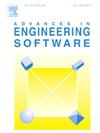Contact fatigue life forecasting model considering micro-scale subsurface stress for aerospace spiral bevel gears
IF 4
2区 工程技术
Q2 COMPUTER SCIENCE, INTERDISCIPLINARY APPLICATIONS
引用次数: 0
Abstract
Focusing on stress distribution at subsurface layer under aerospace service condition in roughness tooth flank meshing interface, a new loaded contact fatigue life forecasting model is developed by considering micro-scale surface effect for aerospace spiral bevel gears. Firstly, tooth flank modeling considering the actual manufacturing process is used for accurate tooth flank point determination having high and uniform grid density. Then, with application geometric approximation and operation, discrete convolution and fast Fourier transformation (DC-FFT) based conjugate gradient (CG) method is applied to determine time-varying load distribution. While at normal direction of each point from the high-density tooth flank discretization after accurate interpolation is added the roughness height from the actual micro-scale geometric topography measurement, a tooth flank reconstruction is performed to determine the micro- scale geometric topography. Then, elastic half-space loaded contact model and DC-FFT method are employed to compute subsurface stress distribution for roughness tooth flank. Von Mises stress is selected as design variable and introduced into Zaretsky model to establish the contact fatigue life forecasting model. Finally, a spiral bevel gear set in aerospace industrial application is exercised to verify the impact of subsurface stress on contact fatigue life.
考虑微尺度次表面应力的航空螺旋锥齿轮接触疲劳寿命预测模型
针对航空航天服役条件下粗糙度齿面啮合界面次表层的应力分布,通过考虑航空航天螺旋锥齿轮的微尺度表面效应,建立了一种新的加载接触疲劳寿命预测模型。首先,考虑到实际制造过程的齿面建模用于精确确定齿面点,网格密度高且均匀。然后,应用几何近似和运算,基于离散卷积和快速傅里叶变换(DC-FFT)的共轭梯度(CG)方法确定时变载荷分布。在高密度齿面离散化的每个点的法线方向上,精确插值后加上实际微尺度几何形貌测量的粗糙度高度,进行齿面重建,以确定微尺度几何形貌。然后,采用弹性半空间加载接触模型和 DC-FFT 方法计算粗糙度齿面的次表面应力分布。选择 Von Mises 应力作为设计变量,并将其引入 Zaretsky 模型,从而建立接触疲劳寿命预测模型。最后,以航空航天工业应用中的螺旋锥齿轮组为例,验证了次表面应力对接触疲劳寿命的影响。
本文章由计算机程序翻译,如有差异,请以英文原文为准。
求助全文
约1分钟内获得全文
求助全文
来源期刊

Advances in Engineering Software
工程技术-计算机:跨学科应用
CiteScore
7.70
自引率
4.20%
发文量
169
审稿时长
37 days
期刊介绍:
The objective of this journal is to communicate recent and projected advances in computer-based engineering techniques. The fields covered include mechanical, aerospace, civil and environmental engineering, with an emphasis on research and development leading to practical problem-solving.
The scope of the journal includes:
• Innovative computational strategies and numerical algorithms for large-scale engineering problems
• Analysis and simulation techniques and systems
• Model and mesh generation
• Control of the accuracy, stability and efficiency of computational process
• Exploitation of new computing environments (eg distributed hetergeneous and collaborative computing)
• Advanced visualization techniques, virtual environments and prototyping
• Applications of AI, knowledge-based systems, computational intelligence, including fuzzy logic, neural networks and evolutionary computations
• Application of object-oriented technology to engineering problems
• Intelligent human computer interfaces
• Design automation, multidisciplinary design and optimization
• CAD, CAE and integrated process and product development systems
• Quality and reliability.
 求助内容:
求助内容: 应助结果提醒方式:
应助结果提醒方式:


